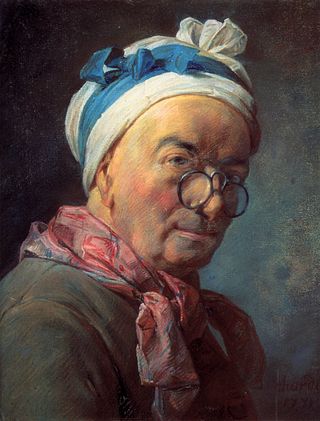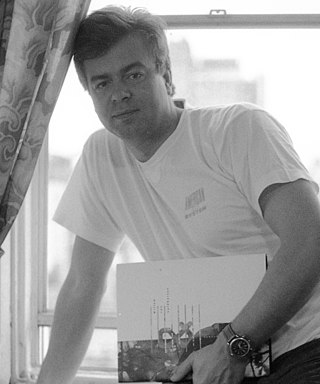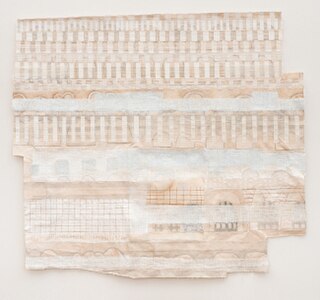
Jean Siméon Chardin was an 18th-century French painter. He is considered a master of still life, and is also noted for his genre paintings which depict kitchen maids, children, and domestic activities. Carefully balanced composition, soft diffusion of light, and granular impasto characterize his work.

Gerrit Rietveld was a Dutch furniture designer and architect.

André Derain was a French artist, painter, sculptor and co-founder of Fauvism with Henri Matisse.

Abstract art uses visual language of shape, form, color and line to create a composition which may exist with a degree of independence from visual references in the world.

Hard-edge painting is painting in which abrupt transitions are found between color areas. Color areas often consist of one unvarying color. The Hard-edge painting style is related to Geometric abstraction, Op Art, Post-painterly Abstraction, and Color Field painting.

Monochromatic painting has played a significant role in modern and contemporary Western visual art, originating with the early 20th-century European avant-gardes. Artists have explored the non-representational potential of a single color, investigating shifts in value, diversity of texture, and formal nuances as a means of emotional expression, visual investigation into the inherent properties of painting, as well as a starting point for conceptual works. Ranging from geometric abstraction in a variety of mediums to non-representational gestural painting, monochromatic works continue to be an important influence in contemporary art.

Willem Hendrik "Wim" Crouwel was a Dutch graphic designer, type designer, and typographer.
Shaped canvases are paintings that depart from the normal flat, rectangular configuration. Canvases may be shaped by altering their outline, while retaining their flatness. An ancient, traditional example is the tondo, a painting on a round panel or canvas: Raphael, as well as some other Renaissance painters, sometimes chose this format for madonna paintings. Alternatively, canvases may be altered by losing their flatness and assuming a three-dimensional surface. Or they can do both. That is, they can assume shapes other than rectangles, and also have surface features that are three-dimensional. Arguably, changing the surface configuration of the painting transforms it into a sculpture. But shaped canvases are generally considered paintings.

Ellsworth Kelly was an American painter, sculptor, and printmaker associated with hard-edge painting, Color field painting and minimalism. His works demonstrate unassuming techniques emphasizing line, color and form, similar to the work of John McLaughlin and Kenneth Noland. Kelly often employed bright colors. He lived and worked in Spencertown, New York.
Michael Raedecker is a Dutch artist who works in the United Kingdom.

Mark Grotjahn is an American painter best known for abstract work and bold geometric paintings. Grotjahn lives and works in Los Angeles.

Jack Reilly is an American artist known for his complex shaped canvas paintings. His work is widely exhibited and included in public and private collections internationally.
Vincent Cavallaro was a painter, sculptor and abstract artist. He was born in Cambridge, Massachusetts and died in New York City. He was a United States citizen, raised and educated in Italy (Milan).

The Gerrit Rietveld Academie, also known as Rietveld School of Art & Design and Rietveld Academy, is an art academy in Amsterdam, Netherlands. It was founded in 1924 and offers programs in fine arts and design.

Antonio Jose Guzman is a Dutch Panamanian visual artist, communication designer and lecturer. He lives and works in Amsterdam, Panama City and Dakar.

Willem van Veldhuizen is a Dutch painter, known for his photorealism and hyperrealism paintings of his museum interiors.
Mino Argento is an Italian painter, mainly depicting abstract themes on canvas and paper.

Tania was a Polish-born Jewish American abstract painter, sculptor, collage artist and painter of city walls.

Harriet Korman is an American abstract painter based in New York City, who first gained attention in the early 1970s. She is known for work that embraces improvisation and experimentation within a framework of self-imposed limitations that include simplicity of means, purity of color, and a strict rejection of allusion, illusion, naturalistic light and space, or other translations of reality. Writer John Yau describes Korman as "a pure abstract artist, one who doesn’t rely on a visual hook, cultural association, or anything that smacks of essentialization or the spiritual," a position he suggests few post-Warhol painters have taken. While Korman's work may suggest early twentieth-century abstraction, critics such as Roberta Smith locate its roots among a cohort of early-1970s women artists who sought to reinvent painting using strategies from Process Art, then most associated with sculpture, installation art and performance. Since the 1990s, critics and curators have championed this early work as unjustifiably neglected by a male-dominated 1970s art market and deserving of rediscovery.

Drew Shiflett is an American visual artist based in New York. She is known for layered, collaged paper and fabric constructions that straddle drawing, relief and sculpture. These handmade, hybrid works, which she terms "constructed drawings," offer subtle examinations of surface, structure and texture through their attention to materials, intuitive processes, and loose patterning. They consist of monochromatic, interwoven sections of handmade paper and fabric upon which she draws repetitive and sectioned lines and marks, producing meditative, quilt-like "grids of grids." Writing about her later work, critic Raphael Rubinstein observed, "One of the pleasures of Shiflett's art is being able to follow her process step by step, relishing the care with which each element has been positioned, the unpredictable but somehow always apposite interruptions of patterning. Employing a distinctive eccentric modularity, [she] lets each of her wall pieces develop gradually."

















